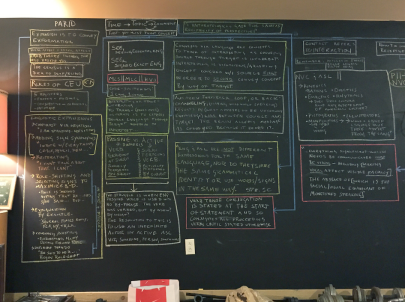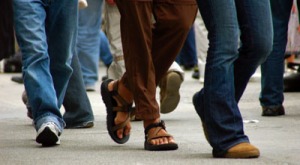We, the standing primate of bipedal locomotion, could walk sidling like a crab, like an Egyptian or as if we’ve attended the Ministry of Silly Walks…

…and the fact will still remain: the direction in which the feet point is an expression of direction, an expression of goal. It is an expression of intent.
In this post I am going to address some general topics regarding the nonverbal communication of the feet so as to set the foundation for following posts regarding more specific material regarding this.
The feet speak:
“There is where I want to be.”
It began in the trees some 4-6 million years ago when our hominid ancestors evolved into that missing link ancestor and required the use of their hands more for transporting objects than for aiding their quadrupedalism and so began to walk upright. The fingers were liberated to carry; they were free to evolve their tactile abilities and their sensitivity while the feet evolved a very different purpose.
Givens succinctly labels the feet as “smart-parts” used for, “standing, walking, dance and display,” and they, “reveal dominance and submission by toeing out or toeing in, respectively. Inadvertently [pointing toward or angling away] from liked or disliked individuals.”
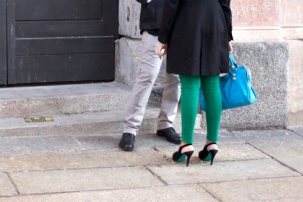
Nonverbal communication always must be evaluated in context and clumps of gestures and not on any single body part alone. If, for example, we were to rely on a single body part to represent the intent or feelings of an individual it would be an erroneous evaluation; dragging the index finger across one’s nostrils likely implies allergies, a cold or an itch. However, if one drags the index finger across one’s nostril, steps backward and crosses their arms – then there is a cause for further exploration into the context of the conversation in that moment.
The feet are not an exception. If one were to, while standing, press a toe into the ground and lift their heal they may have a sore ankle. Whereas if a person does this gesture while in the middle of courtship behavior it can be labeled as what Joe Navarro calls “gravity-defying behaviors.”

“Whenever we are excited about something or feel very positive about our circumstances, we tend to defy gravity by doing such things as rocking up and down on the balls of our feet, or walking with a bit of a bounce in our step […] Recently I was watching a stranger talk on his cell phone. As he listened his left foot, which had been resting flat on the ground, changed position. The heel of the foot remained on the ground, but the rest of the shoe moved up so that his toes were pointed skyward…
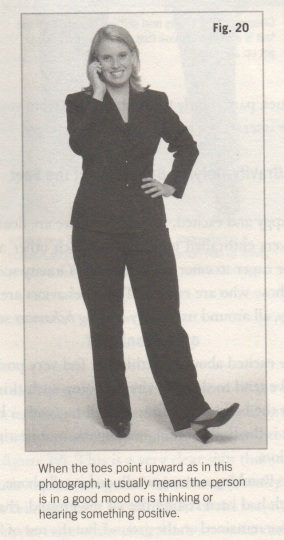
…sure enough, as I walked by I could hear him say, ‘really–that’s terrific!’ His feet had already silently said the same thing.” (Navarro, 2008, p. 63-64)
 This image, by Macduff Everton, is also a perfect example of this gravity-defying behavior. The woman, in an obvious display of courting behavior, lifts one foot from the ground and touches her toe down while leaning against the wall; she is happy to be where she is. “Interestingly,” Navarro notes, “gravity-defying behaviors of the feet and legs are rarely seen in people suffering from clinical depression. The body reflects precisely the emotional state of the individual” (p. 65).
This image, by Macduff Everton, is also a perfect example of this gravity-defying behavior. The woman, in an obvious display of courting behavior, lifts one foot from the ground and touches her toe down while leaning against the wall; she is happy to be where she is. “Interestingly,” Navarro notes, “gravity-defying behaviors of the feet and legs are rarely seen in people suffering from clinical depression. The body reflects precisely the emotional state of the individual” (p. 65).
(There is also the consideration of not only what our feet do but also what our feet wear. This, however, will be considered in a later post. If you do take an interest in this I recommend what Givens has to elaborate on the matter here.)
Nonverbal communication, being the umbrella term that it is, has several sub-categories whose importance is high regarding the subject matter of this post. I will introduce the terms followed by subsequent posts regarding explanations and meanings of each. The terms are interaction markers, regulators, intention cues, and, to a lesser extent, diectic movements and illustrators.
Interaction markers are, precisely as the name implies, nonverbals that indicate what stage of an interaction you are in. They indicate which (and this is important) one of the 3 stages of an encounter you are currently in, “(1) the greeting ceremony, (2) the heart of the encounter or discussion or (3) the farewell ceremony.” Interaction markers are, arguably, one of the more important nonverbals for someone with ASD to look for; since they indicate the stage of the interaction you are currently experiences then very few social norms are left to be confused or anxious about. (Egolf, Donald The Non-Verbal Factor p.168).
Regulators are nonverbals that regulate the interaction you are having. These differ from interaction markers in that they lead into or follow from the 3 stages of interaction. For example, meeting eyes with a friend, standing, walking towards them and extending your hand to grasp their in the shake are regulators as they indicate that the greeting ceremony that is the two of you shaking hands and saying hello is about to begin. When you are shaking hands is when you are in the greeting ceremony which is an interaction marker.
Diectics are nonverbals that point to an object, place or event and are rarely seen in the feet. If, however, a person is seated and giving you directions it wouldn’t be out of the question to see one of their feet point in the directions they are giving to you.
Illustrators are any nonverbals that indicate that a person is, simply, following a train of thought while they are speaking and so, accordingly, it would be easy to see the role the feet would play in this. Specifically, Ekman states, “illustrators are used to help explain ideas that are hard to put into words” (Telling Lies p. 106).”
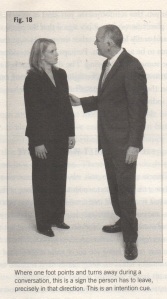 Intention cues are nonverbals that indicate what we intend to do and not what we are doing. Picture any person, in any situation requiring walking, and thing of their feet. The backside of the foot is pointed towards the location from which we came and the frontside of the foot is pointed towards the location we are intent on arriving at. The feet, of an averagely developed leg, point straight out from the body. The foot is telling the observer, “that is what I am interested in,” regardless of it being a destination or a person with whom one is talking to. In the event, however, that feet are not pointed at the person with whom one is speaking – it is possible to say their interest lays elsewhere. For example, if you look down and see the feet of your conversation partner and one foot is pointed directly at you and the other is pointed directly at the door – this is regulator telling you that the farewell ceremony is about to begin.
Intention cues are nonverbals that indicate what we intend to do and not what we are doing. Picture any person, in any situation requiring walking, and thing of their feet. The backside of the foot is pointed towards the location from which we came and the frontside of the foot is pointed towards the location we are intent on arriving at. The feet, of an averagely developed leg, point straight out from the body. The foot is telling the observer, “that is what I am interested in,” regardless of it being a destination or a person with whom one is talking to. In the event, however, that feet are not pointed at the person with whom one is speaking – it is possible to say their interest lays elsewhere. For example, if you look down and see the feet of your conversation partner and one foot is pointed directly at you and the other is pointed directly at the door – this is regulator telling you that the farewell ceremony is about to begin.
